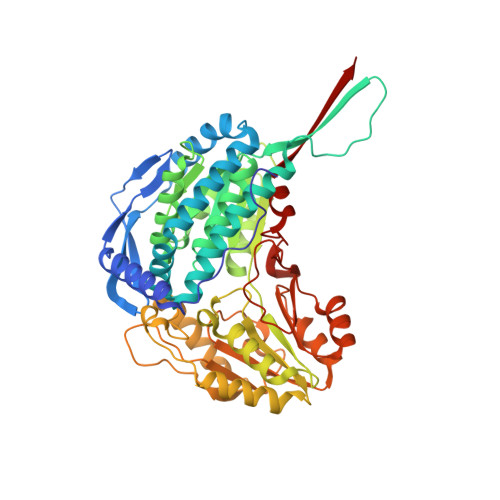Structural determinants of oligomerization of delta (1)-pyrroline-5-carboxylate dehydrogenase: identification of a hexamerization hot spot.
Luo, M., Singh, R.K., Tanner, J.J.(2013) J Mol Biol 425: 3106-3120
- PubMed: 23747974
- DOI: https://doi.org/10.1016/j.jmb.2013.05.027
- Primary Citation of Related Structures:
4K57 - PubMed Abstract:
The aldehyde dehydrogenase (ALDH) superfamily member Δ(1)-pyrroline-5-carboxylate dehydrogenase (P5CDH) catalyzes the NAD(+)-dependent oxidation of glutamate semialdehyde to glutamate, which is the final step of proline catabolism. Defects in P5CDH activity lead to the metabolic disorder type II hyperprolinemia, P5CDH is essential for virulence of the fungal pathogen Cryptococcus neoformans, and bacterial P5CDHs have been targeted for vaccine development. Although the enzyme oligomeric state is known to be important for ALDH function, the oligomerization of P5CDH has remained relatively unstudied. Here we determine the oligomeric states and quaternary structures of four bacterial P5CDHs using a combination of small-angle X-ray scattering, X-ray crystallography, and dynamic light scattering. The P5CDHs from Thermus thermophilus and Deinococcus radiodurans form trimer-of-dimers hexamers in solution, which is the first observation of a hexameric ALDH in solution. In contrast, two Bacillus P5CDHs form dimers in solution but do not assemble into a higher-order oligomer. Site-directed mutagenesis was used to identify a hexamerization hot spot that is centered on an arginine residue in the NAD(+)-binding domain. Mutation of this critical Arg residue to Ala in either of the hexameric enzymes prevents hexamer formation in solution. Paradoxically, the dimeric Arg-to-Ala T. thermophilus mutant enzyme packs as a hexamer in the crystal state, which illustrates the challenges associated with predicting the biological assembly in solution from crystal structures. The observation of different oligomeric states among P5CDHs suggests potential differences in cooperativity and protein-protein interactions.
Organizational Affiliation:
Department of Chemistry, University of Missouri-Columbia, Columbia, MO 65211, USA.















